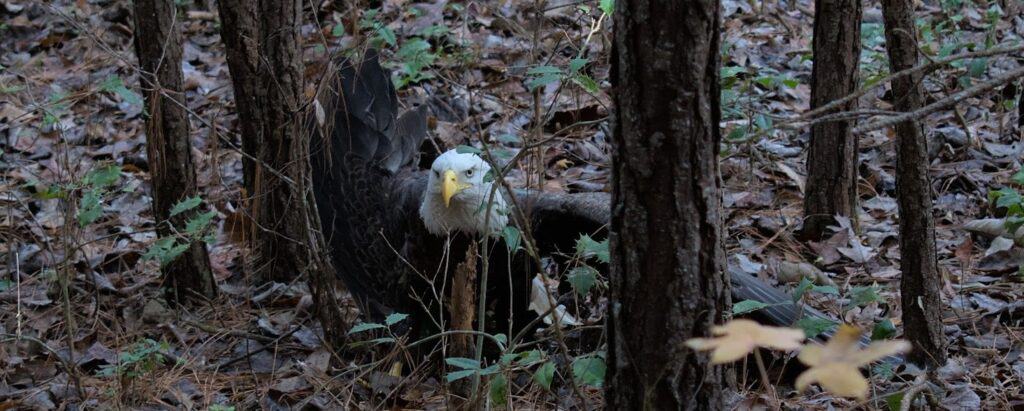A Look At AWARE’s Efforts To Save One Local Bald Eagle

From early December to late February, AWARE staff and volunteers tried to save a badly injured bald eagle found at Panola Mountain.
Early Sunday morning on December 4th, Scott Lange, Executive Director of AWARE Wildlife Center, was still making breakfast and shaking off sleep when he heard his phone ring. It was Ranger Jarrod Simpson from Panola Mountain State Park, calling about, of all things, an injured bald eagle. “My first thought was that it probably wasn’t a bald eagle because we get those calls all the time, and it’s never a bald eagle,” said Lange. “But in this case, it was a park ranger and he seemed quite certain.”
Lange immediately drove to Panola Mountain, where he and other volunteers found the injured bird about a quarter mile down a trail into the woods. “I had only seen a bald eagle in the wild once in my entire life: at a dam on the Chattahoochee almost twenty years ago, but it was unmistakable,” said Lange. “Once my eyes processed the sight, something else was unmistakable—his broken right wing, pointing off at a disconcerting angle.”

The other volunteers surrounded the massive raptor and slowly closed their circle around him until someone could throw a towel over the bird to restrict his vision and movement. Then they put a plastic bin over the eagle, slid the lid underneath, flipped him up, and he was contained.

Scott Lange (left) and another volunteer with the captured eagle.
A Risky Operation

An X-ray of the eagle’s broken wing.
Lange drove back with the eagle to AWARE at the base of Arabia Mountain in Stonecrest. He met with Marjan Ghadrdan, the organization’s Director of Animal Care, who performed the initial examination of the injured animal. “I could see his humerus bone sticking out, and his wing was spun completely around—usually that’s a death sentence,” said Ghadrdan, who’s rehabilitated several bald eagles. “At the very least, they’re never going to fly again with an injury like that. But there was a chance that he could be saved, so we thought, Let’s try.”
Upon closer examination, Ghadrdan also noticed a serious eye injury and some abrasions on his jaw—all from blunt force trauma. She concluded that the raptor was likely struck by a motor vehicle, one of the most common sources of animal injury and death. “Oftentimes these animals are by the road because someone has thrown some food out the window,” said Ghadrdan. “People think that because it will biodegrade it’s okay, but food is litter too.” Litter that attracts local wildlife.
In early December, Veterinarian Dr. Holly Burchfield and Ghadrdan performed the surgery on the bald eagle that involved putting the broken humerus back inside the wing, aligning the wing and fractured bone, and suturing the wound. Afterward, the bird began his recuperation at AWARE, becoming its first bald eagle patient in eleven years.

As a national symbol and federally protected species, there are many laws regarding the handling and captivity of bald eagles. AWARE frequently checked in with the U.S. Fish and Wildlife Service and Georgia Department of Natural Resources about the bird’s health and decisions regarding his future.
Bird In Rehab
The first two weeks of rehab went well. The large eagle required a large effort from the center’s senior staff. “Our team worked extra hours to give him the best possible care,” said Lange. “He was so big and strong that only our senior staff were able to restrain him, and so twice a day, one of them would come in to medicate him, sometimes on their off-days.”

Dr. Holly Burchfield and Marjan Ghadrdan in surgery with an wounded bald eagle.
However, in spite of the staff’s care and attention over two months—and multiple follow-up procedures to coax the broken wing back together—the eagle’s injury would not heal properly. Tissue began growing between the bones, forcing them back apart, basically re-fracturing the break. “To fix that, the surgery is incredibly risky with a more than 50 percent fatality rate,” said Ghadrdan. “Even if we did get that wing back together, he was probably always going to be in pain. We want to make sure every animal that’s placed in education after rehab can have a good quality of life.”
A Tough Decision

Marjan Ghadrdan with the eagle at AWARE.
After weighing the options, AWARE along with U.S. Fish and Wildlife agreed that there was no good option to saving the bald eagle. Lange and Ghadrdan were at AWARE in late February when they decided to say goodbye to the bird. “It was really sad,” said Ghadrdan. “We were all rooting for him. But the ones you love the most are usually the ones that don’t make it, and exactly because they are in such critical condition. I felt so bad for everyone who put in so much effort and time. He was so full of life and so calm.”
AWARE has offered the eagle’s body to the National Eagle Repository. The Repository distributes eagle feathers to Native American tribes that use them for spiritual and ceremonial purposes. “Though we’re heartbroken at not being able to save him,” Lange said, “I take solace in knowing he got the best possible chance at recovery.”